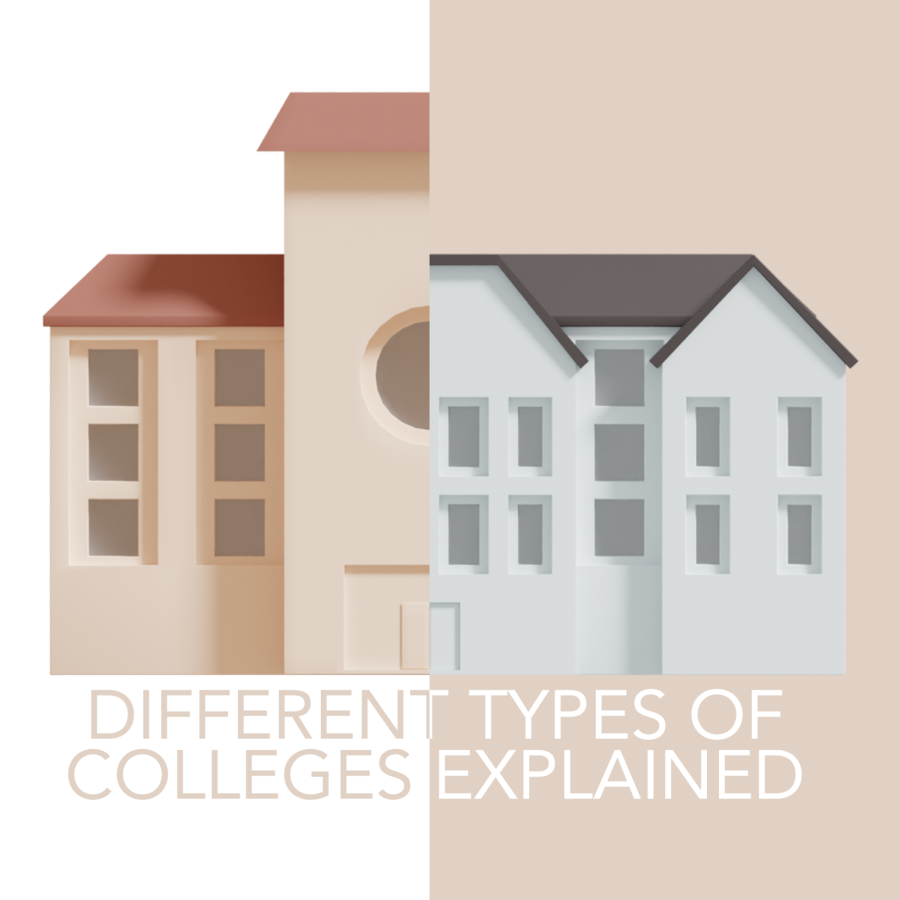Different types of colleges explained
April 18, 2022
Even though there are endless ways to navigate the college application process, many students forget one important aspect of the journey: what type of college would they benefit from attending?
Ian Kim, a senior at West Ranch expressed, “participating in various extracurriculars has solidified my desire to pursue my passion in film. In addition to research and visiting different campuses, being able to attend an institution where I can continue to get that hands-on experience has been a key component I’ve looked for when I applied to film school.”
West Ranch sophomore Keyan Saguibo explained that although he has a very general idea about the college application process, he isn’t sure what type of institution would best fit him.
“For now I would like to go into the STEM field, and I know a big part of landing a career in that field is your research opportunities,” Saguido said. “I would love to attend a place where I can get that experience, but also build [closer] relationships with my professors and peers.”
Although the media continues to place a higher emphasis on top-name schools, they are not always the best fit for every student. Luckily, learning different types of schools can assist in planning out a student’s future.
College vs. University
In California alone, there are over 281 colleges and universities, with some of the most well known universities and colleges in the country being part of the University of California system, and the California State University system.
The terms “college” and “university” are often used interchangeably. However, they differ in program offerings and degree types.
According to U.S. News, a college is a smaller establishment in which undergraduate education is prioritized. Colleges often have smaller class sizes and provide students with personalized attention from faculty and advisors. But compared to universities, they may be less devoted to research efforts.
Universities on the other hand, are larger institutions that offer both undergraduate and graduate degree programs. Many universities have associated graduate professional schools for law, medicine or business.
Universities provide many opportunities for hands-on learning through independent research and partnerships with graduate students on various projects. With this in mind, the focus on research over undergraduate teaching sometimes means that faculty at universities are less engaged with students.
Universities are also often divided into smaller subsections called “colleges.” Each of these colleges has a specific academic focus such as business, engineering or social work. Prospective undergraduate students typically tend to choose a major in a college such as “The College of Arts & Sciences” or “The College of Engineering.”
All in all, large universities offer an almost limitless variety of academic pathways, people and resources, whereas small colleges promise a close-knit community and more intimate classroom settings.
There are advantages and disadvantages to each type of higher education institution. It’s up to the individual to determine which one best aligns with their personality, interests and goals.
Beth Powell, a senior at West Ranch, shared, “[In the future] I hope to attend a university, or an institution that is larger due to the fact that I can meet more people and find more options for majors. A plus to attending those bigger universities is that they will normally have sports teams that can be fun to go watch.”
Private
According to the College Board, a private college is dependent on tuition, fees and private sources for funding. Currently, there are 1,660 private nonprofit four-year and two-year schools and 697 for-profit schools in the United States of the 3,982 institutions listed by the National Center for Education Statistics (NCES).
There are a few differences between public and private colleges, with the key difference being the cost of higher education.
Student Loan Hero, a service that helps students manage and repay their student loan debt, explained that private colleges and universities, in contrast to public colleges and universities, rely on student tuition fees, alumni networks, and endowments to fund their academic programs.
Typically, private colleges are categorized into either for-profit or nonprofit. According to the Grand Canyon University website, a for-profit university, a for-profit college is a college owned and operated by a private company or business. They are often managed by investors and stakeholders and they generate revenue that is usually used for non-educational purposes.
In contrast, money made by nonprofit colleges goes directly back to a student’s education. A nonprofit college channels funds from tuition and fees into educational programs. By tending to spend more money on instruction, curricula development and recruitment than their for-profit counterparts, nonprofit colleges generally boast better reputations than for-profit schools.
Ms. Reynoso, West Ranch Head Counselor, explains that choosing a private versus a public school is “a very personal decision. Some students want a larger public school where they have access to all sorts of things. Some kids want more of an intimate experience – so smaller to medium size. Those are all different factors.”
As private schools tend to receive little to no funding from state governments, the cost of attendance is usually much higher. Currently, the average national tuition price at private, four-year colleges is $30,065—more than 250% higher than the average cost for public, in-state students, according to the Nation Center for Education Statistics as of 2020.
Both public and private colleges provide federal financial aid to students. Private institutions, however, often have more money available to award grants and scholarships due to their large endowment funds, according to BestColleges. According to the National Association of College and University Business Officers, private institutions extended a record average 48% tuition discount to undergraduates for the 2020-2021 school year.
While private colleges are often more expensive than public schools, financial aid packages and tuition discounts can sometimes make them more affordable.
Public
Public colleges, commonly known as state universities, are the most “popular” type of institutions that students enroll in, with approximately 75% of all college students attending a public university, according to the College Enrollment Statistics. Out of the 3,982 institutions listed by NCES, 1,626 public universities make up colleges in the United States.
The name “state university” comes from how colleges receive their funding. Public schools are largely funded by state and federal governmentsIn other words, government subsidies cover the majority of the cost so students don’t have to pay the full price.
This is partly why tuition is a lot lower for in-state students than it is for out-of-state students, as the former’s tax dollars help with funding. In 2020-2021, the national average cost of tuition and fees at public, four-year colleges is $18,809 for out-of-state students and only $8,487 for in-state students (NCES, 2020).
Senior Powell spoke about the challenges that come with choosing a college “Today, going to college is a very risky decision because the cost is so high. You have to project what you want to do with a degree and determine if the money it will generate for you is on par with how much you’re spending to get it.”
She continued sharing that whenever she hears people say they have an upwards of $100,000 worth of debt and earn an income less than $30,000, she “cringes.”
“[I need to] choose a school I can afford, because in the end, my career pathway doesn’t care about the college’s name. They care about who I am as a person and the type of experiences I’ve gained from my time in college.”
Community College System
A community college, also referred as a junior college, is a postsecondary institution that offers a two-year program leading to an associate’s degree. Other programs include a transfer program leading to a four-year degree, occupational programs, and one- and two-year study programs.
The major difference between a community college and a university is that most community college degrees are completed in two years, whereas four-year university undergraduate degrees are, for the most part, completed in four years.
General education is the required curriculum that makes up the foundation of an undergraduate degree. All students pursuing higher education are required to take this curriculum as it makes up the foundation of an undergraduate degree. In community college, to reduce the cost of tuition in addition to bridge the jump from highschool to college, many students will complete their general education at community college.
Additionally, another difference is “for four year universities you have to apply, and they have a variety of different requirements – most of them, if you follow the A-G requirements, you’re going to be hitting them all for colleges across the country and even abroad – where community colleges – the requirements are to graduate high school or have the GED,” Ms. Reynoso explained.
The traditional four-year college route isn’t for everyone. Some are still deciding which route to take while others are looking for a more affordable education. Money is also a big factor in deciding the next step in a students’ academic career. The average national student loan debt per student is around $36,937 as of 2021, according to Credible. To avoid this, students may choose community institutions that typically have a lower tuition than four-year colleges and universities. Even if you transfer later to a four-year institution, starting at a community college allows you to earn a significant amount of credits at a lesser cost.
Canyons Promise at the College of the Canyons is a program dedicated to removing financial obstacles and barriers to students who are unable to access higher education. The program gives incoming first-time college students the opportunity to attend College of the Canyons tuition free for their first two years. Canyons Promise provides financial support, personalized academic counseling, and peer collaboration to students who enroll full time.
Like any place of higher education, community colleges have its disadvantages. If you are pursuing a 2-year path at a community college which will eventually lead to a Bachelor’s degree, your options for a major may be limited. Most local community colleges offer Associate degrees, known as an AA. A Business Administration AA, Nursing AA, and Theater AA are a few Associate Degrees offered at the local community college, College of the Canyons.
Taking the community college route has its benefits and drawbacks, but it’s about finding a path that’s right for you that really matters. Whether junior college or four-year university, public or private, finding your fit is most important.
Final thoughts
Finding the right college is a long process. Ms. Reynoso advised students to “start [applications] early and do your research.”
“If you wait until the last minute, none of your applications are going to be as strong as it would if you started early,” she explained. “Also know that your counselor is here for you, so ask a whole lot of questions! Take a deep breath because you got this,” she said. Whether college or university, public or private, or junior college or four-year program, the most important factor is finding your own fit. For instance, the environment of the campus is different everywhere you go. Reynoso elaborated, “Now that covid restrictions are lifted, I think that it’s going to be a lot easier for kids to go and be on a campus and experience a campus. A lot of times you start to figure out what it is you don’t want in a school, so that you can find what you do want in a school.”
Mrs. Reynoso explained, “Most importantly, not only the environment, but making sure they offer the major the student is looking for. Sometimes kids look for a school just because it has a name brand, but yet they don’t offer the major they may be looking for. I always say, if you don’t know your major, it’s always good to pick a school that has a broad selection. So that if you change your mind, you don’t have to change campuses.”
Good luck on college application Cats! There are many people rooting for you!




